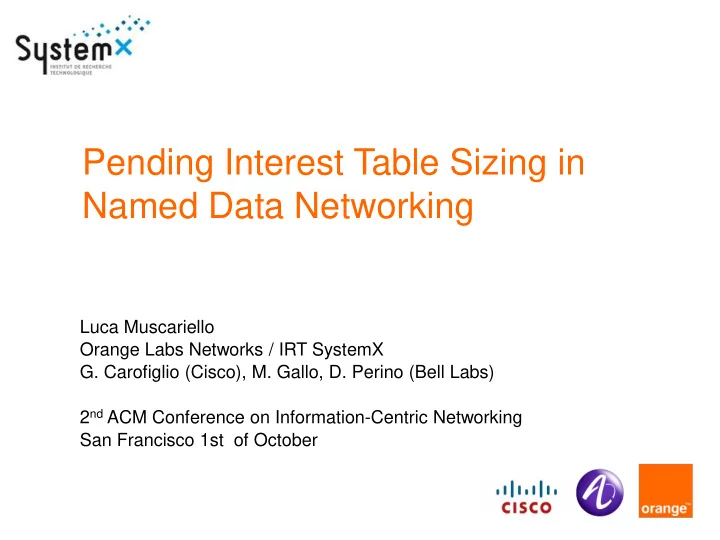

Pending Interest Table Sizing in Named Data Networking Luca Muscariello Orange Labs Networks / IRT SystemX G. Carofiglio (Cisco), M. Gallo, D. Perino (Bell Labs) 2 nd ACM Conference on Information-Centric Networking San Francisco 1st of October
motivation the pending interest table is responsible for maintaining the data path in NDN it is a key data structure that requires careful dimensioning when the PIT is full it is not obvious how to manage it we want to compute the distribution of the PIT size under realistic traffic assumptions PIT size as a function of the offered traffic load 2
outline 1 system dynamics 2 mathematical modeling 3 sizing 3
dynamics (1/2) Egress Ingress Data 1 served by local cache interest 1 CS Data 1 face 1 interest 2 Data 2 PIT FIB (ingress, interest) (prefix, egress) 4
dynamics (2/2) interests (ingress, interest) Data (ingress, interest) Data (ingress, interest) Data (ingress, interest) Data PIT size • Interest arrival process • Interest lifetime 4 3 2 1 0 x x x x x x x x time 5
traffic model we want to compute the size of the PIT as a function of the offered traffic for sizing purposes we want the quantiles under some general assumptions: objects are requested following a random process we chose an object Poisson arrival process with rate λ – an object has distributed size S with finite average an object is retrieved by variable rate interest requests – the rate is congestion controlled – the congestion control protocol is receiver driven – is also delay based – cf Carofiglio et al IEEE ICNP 2013 6
two levels model of the interest rate N(t) = 3 N(t) = 2 fluid rate N(t) = 2 N(t) = 1 N(t) = 1 N(t) = 0 time 7
two levels model of the interest rate N(t) = 3 N(t) = 2 fluid rate N(t) = 2 N(t) = 1 N(t) = 1 N(t) = 0 time 8
single transfer PIT occupancy (line network) Downlink queue Q i node i Data rate X i Repository C i ~ Request rate X i Pending Interest Table π i 9
state equations (1/2) Interest rate Data rate Interest rate decrease ratio receiver interest rate link input/output rates rate PIT size 10
state equations (2/2) congestion function Round trip time Link queue evolution 11
network model the network is a directed graph data object retrievals sharing the same route r in the network are grouped in classes be the set of routes flowing through link in case of link congestion capacity is shared assuming max-min fairness (approximation or fair queueing assumed) with fair rate the number of data transfers in progress on route is a Markov process stability is guaranteed by the condition being ρ the offered load on link 12
main results (1/2) • N flows, single routing class After a transient phase, PIT sizes, , are empty above the bottleneck ( ) And equal to the bottleneck queue length below: It means that for sizing purposes we need to only focus on the routes that are bottlenecked upstream a given node. 13
main results (2/2) • average values • maximum PIT size in steady state (variance estimation) based on the analysis of the modulus of the Laplace Transform of the bottleneck queue function: taking into account the variable number of transfers in progress 14
experimental analysis (the platform) The platform: – 4 AMC boards in a microTCA – NPU with 4GB off chip DRAM – a set of 10GbE – 12 cores per NPU – 800MHz 64bits MIPS 16kB L1 cache , 2MB L2 cache – an NDN node per card the forwarder: – PIT optimized open-addressed hash table – hardware timers for PIT timeouts – data collection by a platform controller not to affect forwarding – sample are processed offline – faces over UDP 1422B-92B data/interest packets traffic generation on client/repo servers 15
comparison model/experiments line network single bottlenecked link upstream at 100Mbps (all others at 5Gbps) relation PIT size/offered load is correctly measured by the model experiments are run form 100Mbps to 1Gbps 16
PIT sizing PIT sizing is made by using the 95% percentile assuming a Gaussian approximation M routes with the same offered load bottlenecked upstream 17
conclusions the model catches the essential properties of realistic traffic assumptions – congestion controlled sources with delay based congestion control – the knowledge of traffic that is bottleneck upstream is important to compute this size – fluid models turn out to be tractable to obtain simple closed formulas the PIT stores information about congestion level downstream/upstream under congestion controlled traffic the PIT size does not constitute a barrier for high speed implementations for non controlled (poorly controlled) traffic the PIT size requires active (local) management 18
Thank you
Recommend
More recommend